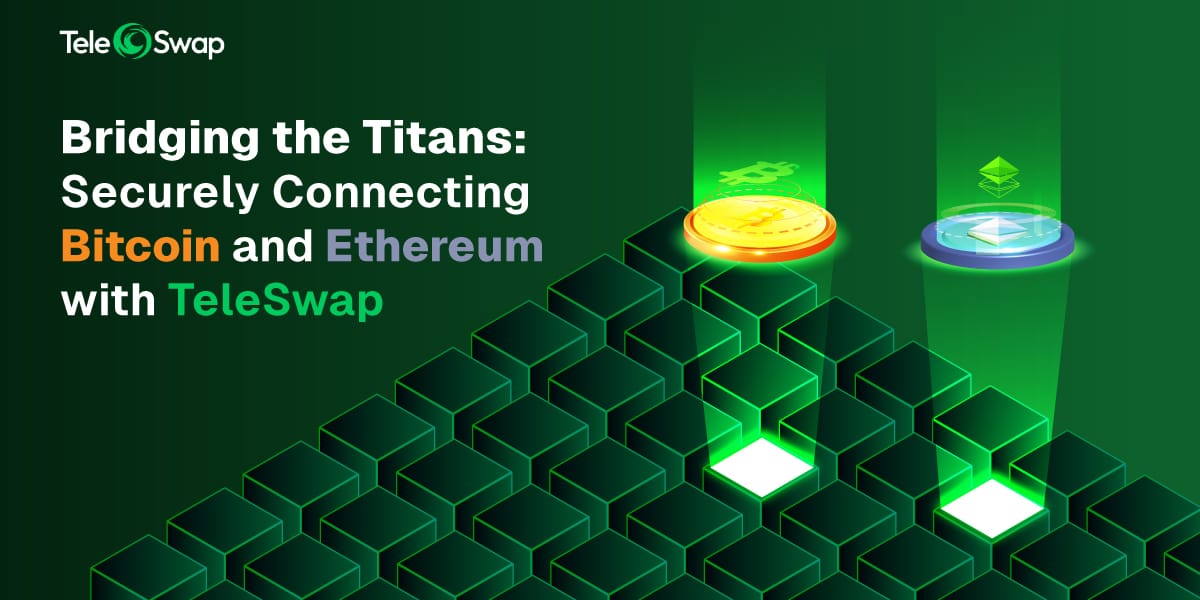Bridging the Titans: Securely Connecting Bitcoin and Ethereum with TeleSwap

1. The Interchain Imperative: Securely Connecting Bitcoin and Ethereum
The digital asset landscape is largely dominated by two colossal forces: Bitcoin (BTC) and Ethereum (ETH). Bitcoin, the progenitor of cryptocurrencies, has firmly established itself as digital gold, a recognized store of value and a hedge against traditional financial system volatility. Ethereum, on the other hand, revolutionized the space by introducing smart contracts, programmable agreements that execute automatically, thereby becoming the foundational layer for decentralized finance (DeFi), non-fungible tokens (NFTs), and a host of other decentralized applications (dApps). These distinct yet complementary roles mean that Bitcoin and Ethereum form the twin pillars supporting much of the burgeoning crypto economy.
However, these powerful blockchains, by their intrinsic design, operate as isolated ecosystems. This inherent separation presents a significant hurdle known as the interoperability challenge. Interoperability refers to the ability of different blockchain networks to communicate and exchange data or assets seamlessly. Without it, the vast liquidity and established value of Bitcoin remain siloed from the dynamic and innovative DeFi ecosystem thriving on Ethereum, and vice versa. Bridging this gap is essential for creating a more cohesive, efficient, and versatile crypto ecosystem. Enabling assets and data to flow freely between chains unlocks numerous benefits, including enhanced asset diversity for users, access to broader liquidity pools, potential scalability solutions by distributing transactional load, and fostering overall ecosystem growth through collaboration and innovation. The very existence and continued development of cross-chain bridges underscore the immense value users and developers place on accessing the unique functionalities and liquidity present on different blockchains. The willingness to engage with these complex mechanisms, even with their associated risks, highlights a market demand for asset mobility that is strong enough to drive innovation in bridging technology.
Cross-chain bridges have emerged as the primary solution to this interoperability dilemma, acting as conduits that allow for the transfer of value and information between otherwise disconnected networks. They hold the promise of a deeply interconnected multi-chain future, enabling sophisticated cross-chain DeFi strategies, expanding the reach of NFTs, and facilitating novel dApp functionalities. Yet, this promise is shadowed by significant peril. Bridges are intricate pieces of technology that often manage substantial amounts of locked assets. This concentration of value makes them highly attractive targets for malicious actors, and the history of decentralized finance is unfortunately punctuated by high-profile bridge exploits. The direct correlation between the value secured by a bridge and its appeal as a target for attackers means that security cannot be an afterthought; it must be the paramount consideration in both the design of bridging solutions and the choices users make when transferring assets. This critical balance between enabling interoperability and ensuring security forms the core challenge in the world of cross-chain communication.
2. Demystifying BTC-ETH Cross-Chain Bridges
Cross-chain bridges, in essence, are protocols that facilitate the transfer of assets or data from one blockchain network to another. When considering Bitcoin and Ethereum, bridges serve the crucial function of allowing Bitcoin, the native asset of the Bitcoin network, to be represented and utilized within Ethereum's smart contract environment, and similarly, enabling Ethereum-based assets to interact with Bitcoin-compatible networks or sidechains. This capability is akin to creating a passage between two distinct digital islands, allowing inhabitants (users and assets) to move between them.
One of the most prevalent mechanisms employed by bridges, particularly for transferring an asset like BTC to Ethereum, is the "lock-and-mint" model. In this process, a user intending to move BTC to Ethereum would first send their BTC to a specific address or smart contract on the Bitcoin blockchain. Once the bridge protocol confirms the deposit, these BTC are effectively "locked." Subsequently, the bridge triggers the minting of an equivalent amount of "wrapped" tokens on the Ethereum network. These wrapped tokens are typically ERC-20 tokens (Ethereum's standard for fungible tokens) that represent the locked BTC on a 1:1 basis. A well-known example of such a wrapped asset is Wrapped Bitcoin (WBTC), though the mechanism itself is broadly applicable. When the user wishes to reclaim their original BTC, the process is reversed: the wrapped tokens on Ethereum are sent back to the bridge and "burned" (destroyed), which then signals the release or "unlocking" of the corresponding BTC on the Bitcoin network. This lock-and-mint (and its counterpart, burn-and-release) system creates a synthetic version of the asset on the target chain, backed by the original asset on the source chain. The integrity and value of this wrapped asset are entirely dependent on the verifiable 1:1 backing with the original, locked asset. Any disruption to this backing, whether through theft of the locked assets or erroneous minting of unbacked wrapped tokens, can lead to a de-pegging event and significant loss of value, highlighting an inherent point of trust or vulnerability in this common bridging model.
The criticality of security in cross-chain bridges cannot be overstated, as they have historically been prime targets for exploits. Several common vulnerabilities and attack vectors persist:
- Smart Contract Flaws: The smart contracts that govern the bridge's operations—locking, minting, burning, and releasing assets—can contain bugs or logical errors. Exploiting these vulnerabilities can allow attackers to drain funds, mint unbacked tokens, or otherwise compromise the bridge's integrity.
- Private Key Compromises: Many bridges, especially earlier or more centralized designs, rely on a set of private keys to authorize transactions or manage the locked assets, often through multi-signature (multisig) wallets. If these keys are stolen, mismanaged, or concentrated in a way that allows a few compromised keys to grant control, attackers can gain unauthorized access to the funds held by the bridge. This has been a recurring theme in some of the largest bridge hacks. For instance, the Ronin Bridge exploit in March 2022 resulted from the compromise of five out of nine validator keys, while the Harmony Bridge hack in June 2022 was due to the compromise of just two out of five multisig keys. These incidents underscore how failures in operational security (OpSec) around private key management can lead to catastrophic losses, even if the underlying blockchain technologies are sound.
- Oracle Reliance and Manipulation: Some bridges depend on oracles—third-party services that provide external data to smart contracts—to relay information about events on one chain to another. If these oracles are compromised or manipulated, they can feed false information to the bridge, potentially leading to incorrect state changes or theft of funds.
- Centralization Risks: Bridges that incorporate centralized components or rely on a small, permissioned set of validators introduce centralization risks. These central points can be targeted by attackers, become subject to censorship, or even act maliciously if compromised. Centralized control over bridge operations or funds directly contradicts the decentralized ethos of blockchain and can create single points of failure.
- Upgrade and Maintenance Coordination: Coordinating upgrades or maintenance across two different blockchain networks and the bridge infrastructure itself can be complex. If not managed carefully, these processes can inadvertently introduce vulnerabilities or periods of heightened risk.
The prevalence of these vulnerabilities, particularly those related to private key management and centralized points of control, suggests that human and procedural elements in bridge operation are often the weakest links.
3. Evaluating Secure Bridging Strategies for Bitcoin and Ethereum
When selecting a method to bridge assets between Bitcoin and Ethereum, understanding the different security models and their inherent trade-offs is crucial. Bridges generally fall on a spectrum from trusted (centralized) to trustless (decentralized) designs.
Trusted (Centralized) Bridges:
These bridges rely on a central entity or a small federation of entities to manage the bridging process. Users deposit their assets with this custodian, who is then responsible for minting the wrapped equivalent on the destination chain and releasing the original assets when bridging back. Security in this model hinges on the trustworthiness and operational security of the central operator(s).
- Pros: Trusted bridges are often faster and offer a simpler user experience because verification and operations can be handled off-chain or by a known set of parties.
- Cons: The primary drawback is the introduction of counterparty risk. Users must trust the custodian not to mismanage, steal, or lose the funds through a hack. These bridges represent a single point of failure; if the operator is compromised, all bridged assets can be at risk. This model also introduces censorship risk and goes against the "not your keys, not your coins" principle, as users relinquish direct control over their assets.
Trustless (Decentralized) Bridges:
These bridges aim to minimize or eliminate reliance on intermediaries by using smart contracts, cryptographic proofs, and decentralized networks of validators or relayers to secure transfers. The idea is that users trust the code and the cryptoeconomic incentives of the protocol rather than a specific entity.
- Pros: If implemented correctly, trustless bridges reduce counterparty risk and align more closely with the decentralized ethos of blockchain technology, allowing users to retain more control or place trust in auditable code.
- Cons: They can be more complex to design and use, potentially leading to higher transaction fees or slower processing times. The "trustless" nature still requires users to trust the integrity of the smart contract code and the security of the underlying consensus mechanisms and validator/relayer sets., A flaw in the code of a trustless bridge can be just as devastating as a compromised custodian in a trusted bridge. The terms "trusted" and "trustless" represent a spectrum, where "trustless" systems shift the locus of trust from identifiable entities to the presumed correctness and security of complex code and decentralized networks. A poorly designed or implemented "trustless" bridge can be far riskier than a transparent and well-managed "trusted" one.
Atomic Swaps: A Peer-to-Peer Alternative:
Atomic swaps offer a distinct approach to cross-chain exchange, enabling direct peer-to-peer (P2P) transfers of cryptocurrencies between different blockchains without relying on any intermediary custodian. They utilize a cryptographic mechanism known as Hashed Timelock Contracts (HTLCs). An HTLC is a smart contract that ensures that a swap is atomic, meaning it either completes fully for both parties or fails and returns the funds to their original owners. This is achieved through a combination of a hashlock (requiring the recipient to provide a cryptographic secret to claim funds) and a timelock (allowing funds to be reclaimed by the sender if the swap isn't completed within a specified timeframe).
- Pros: The primary advantage of atomic swaps is their high security due to the elimination of third-party custodians, reducing counterparty risk significantly. They facilitate direct asset-to-asset swaps and can potentially incur lower costs.
- Cons: Atomic swaps face significant compatibility challenges. For a native atomic swap to work, both blockchains involved typically need to support the same hashing algorithm for the secret and have capabilities for HTLC-like smart contracts. This is a considerable hurdle for direct swaps between chains as fundamentally different as Bitcoin (using SHA-256 primarily) and Ethereum (using Keccak-256 for many functions). While solutions and intermediary layers exist to facilitate such swaps, they add complexity. Other drawbacks can include slower execution times compared to some bridges and potential privacy concerns as the swap process unfolds on-chain. These practical limitations, especially the compatibility issue for disparate chains like Bitcoin and Ethereum, have hindered their widespread adoption for this specific pair, leading users to often opt for bridge solutions despite their inherent risks.
Hallmarks of a Secure Bridging Solution:
Regardless of the specific architecture, several characteristics indicate a commitment to security in a bridging solution:
- Rigorous Security Audits: Comprehensive audits of all smart contracts and underlying infrastructure by reputable, independent third-party security firms are essential.
- Decentralized Validation/Operation: For bridges relying on validators or relayers, a sufficiently large, geographically distributed, and economically incentivized set helps avoid single points of control and collusion.
- Strong Private Key Management: Implementation of best practices such as multi-signature wallets, threshold signature schemes (TSS), use of hardware security modules (HSMs), and robust operational security protocols for any keys involved in bridge operations.
- Continuous Monitoring & Anomaly Detection: Real-time systems to monitor bridge activity, detect suspicious transactions or patterns, and issue alerts are crucial for rapid response to potential threats.
- Transparent Operations & Open Source Code: Making the bridge's codebase open source allows for community scrutiny and verification, fostering trust and potentially identifying vulnerabilities.
- Bug Bounty Programs: Offering financial incentives for ethical hackers to discover and responsibly disclose vulnerabilities can proactively strengthen security.
- Use of Proven Technologies: Relying on battle-tested cryptographic libraries, consensus mechanisms, and well-understood security principles rather than unproven experimental techniques. The increasing complexity and value transacted through bridges are pushing the industry towards a "defense-in-depth" security posture, where multiple layers of technical safeguards (like audits, decentralized validation, and robust cryptography) are combined with stringent operational security measures (like key management and continuous monitoring). No single feature is a panacea; a truly secure bridge employs a holistic and multi-faceted approach.
To better illustrate the differences, the following table compares these bridging strategies:
This comparison highlights that each approach has distinct trade-offs. Light-client bridges, as will be discussed, represent an evolution by attempting to anchor security more directly to the consensus of the participating blockchains.
4. TeleSwap: Pioneering Secure Bitcoin-to-Ethereum Bridging
In the quest for secure cross-chain solutions, particularly for bridging assets between Bitcoin and EVM-compatible networks like Ethereum, TeleSwap emerges as a noteworthy development. This section specifically focuses on this iteration of TeleSwap, designed to facilitate the secure and seamless transfer of Bitcoin assets (including native BTC, BRC-20 tokens, and Runes) to Ethereum and other EVM chains, and vice versa. The core functionalities provided include wrapAndSwap for converting Bitcoin assets into ERC-20 tokens on EVM networks, and swapAndUnwrap for converting these ERC-20 tokens back into Bitcoin assets on the Bitcoin network.
The security architecture of TeleSwap incorporates several key advantages:
- Light-Client Verification: At the heart of TeleSwap’s security model is the use of light-client verification. A light client is a piece of software that connects to a blockchain network but, unlike a full node, does not download and validate every single transaction and block. Instead, it downloads and verifies block headers, which are much smaller summaries of blocks containing cryptographic proof of the work done and the transactions included. Deploys a "Relay contract" on the target chain (e.g., Ethereum). This Relay contract is designed to act like a light client of the source chain (e.g., Bitcoin). It receives block headers from the source chain, submitted by a network of "Relayer nodes," and verifies these headers against the consensus rules of the source chain. This mechanism allows the target chain to independently and cryptographically verify the state of the source chain in a trust-minimized fashion, without needing to trust the honesty of a federated set of validators for the state verification itself. This approach is significant because it anchors the bridge's validity directly to the consensus mechanisms of the connected chains. To corrupt such a bridge, an attacker would theoretically need to compromise the consensus of the source blockchain itself or find a flaw in the light client's verification logic—a considerably more difficult undertaking than compromising a small set of multisig keys that control a traditional bridge's locked funds. This fundamentally alters and reduces the trust footprint compared to many other bridge designs.
- Decentralized Relayer Network: Relayer nodes in the ecosystem are responsible for fetching the latest block headers from the source chain and submitting them to the Relay contract on the target chain. These nodes primarily act as data providers rather than verifiers in the sense of traditional bridge validators who vote on transaction validity. The Relay contract itself performs the verification. Relayers are incentivized to provide accurate and timely data, contributing to the network's liveness and security.
- Capital Efficiency and Reduced Collateral Risk: A notable aspect of TeleSwap's design is that it aims to enhance capital efficiency by not requiring large amounts of collateral to be locked within the bridge protocol itself to secure its operations. In many bridge designs, especially those involving synthetic assets, the locked collateral can become a massive honeypot, attracting attackers. By minimizing this locked collateral, the potential impact of certain types of exploits can be reduced.
- Commitment to Decentralization: The architectural choices, particularly the reliance on light-client verification and a distributed network of relayers, reflect a strong commitment to decentralization. The goal is to move away from centralized points of control and trust, which have been common failure points in other bridging solutions. While some TeleSwap implementations are noted as Telegram mini-apps for chains like TON or Starknet for Bitcoin-EVM bridging is built with decentralization and trust-minimization as core tenets.
- Security Audits: The TeleSwap bridging protocol has undergone security audits, as indicated by DeFiLlama. This is a critical hallmark of a project committed to security, providing an additional layer of assurance through independent expert review. (It is important to distinguish this from audits for other projects that might share a similar name, such as the TapSwap audit mentioned in, which appears to be unrelated.)
By leveraging these architectural strengths, TeleSwap aims to address common security concerns prevalent in other bridge designs:
- Mitigating Private Key Risks: The core validation relies on cryptographic proof derived from block headers rather than a small set of administrator keys controlling vast sums of locked assets. While the security of relayers' operational keys remains important, the fundamental security of state verification is tied to the source chain's consensus.
- Reducing Centralization Risks: Light-client verification is inherently more decentralized in its trust model than relying on a single custodian or a small, permissioned validator set for attesting to cross-chain states.
- Enhancing Smart Contract Security: While smart contracts are integral to the bridge's operation, the core logic of verifying block headers is a well-defined cryptographic process. This, combined with thorough security audits, contributes to a more robust smart contract environment.
Regarding user experience, TeleSwap provides a Software Development Kit (SDK) for its Bitcoin-EVM bridge. This SDK allows developers to integrate TeleSwap's bridging functionalities into their own decentralized applications or build user-friendly interfaces on top of the secure base protocol. While some platforms named "TeleSwap" are presented as Telegram mini-apps offering ease of use, it is the TeleSwap-powered infrastructure that provides the core secure bridging capability for Bitcoin to Ethereum. The availability of an SDK ensures that this secure foundation can be leveraged across various applications, offering flexibility in how users interact with the bridge.
5. Conclusion: Advancing Towards a Securely Interconnected Multi-Chain World
The journey to connect disparate blockchain ecosystems like Bitcoin and Ethereum is fraught with challenges, yet it is essential for the continued growth and maturation of the digital asset space. As this multi-chain landscape expands, the demand for transferring assets and data across networks will only intensify. Consequently, the security of the bridges facilitating these transfers becomes not just a feature but a fundamental necessity. The significant financial losses and erosion of user trust resulting from bridge exploits serve as stark reminders of the high stakes involved.
The evolution of cross-chain bridge technology is a continuous process, marked by innovation and a persistent drive to overcome security hurdles. Early bridge designs, while functional, often introduced significant trust assumptions or centralized points of failure. However, the industry is learning and adapting. Advanced mechanisms, such as the light-client verification employed by protocols like TeleSwap powering TeleSwap, represent substantial progress. These newer approaches aim to minimize trust in intermediaries by anchoring the security of cross-chain transfers more directly to the robust cryptographic and consensus mechanisms of the underlying blockchains themselves. This shift towards more cryptographically secure and less human-trust-dependent solutions is crucial for reducing systemic risk and building sustainable user confidence in the multi-chain paradigm.
Empowering users to make informed decisions is paramount. When considering a cross-chain transfer, individuals and institutions should diligently research the security models of the bridges they intend to use. Key indicators of a security-conscious solution include comprehensive and transparent security audits by reputable firms, a high degree of operational decentralization, robust private key management practices (where applicable), open-source code for community review, and a clear commitment to leveraging proven, battle-tested technologies.
Ultimately, the development and adoption of secure and trust-minimized bridging solutions are foundational to realizing the full potential of Web3. By enabling assets like Bitcoin to safely and efficiently participate in diverse ecosystems like Ethereum's DeFi landscape, and vice versa, these technologies pave the way for a more fluid, interconnected, and valuable global blockchain network. While no solution can offer guarantees in the dynamic field of cybersecurity, the ongoing advancements in bridge architecture, exemplified by solutions like TeleSwap, signal a promising trajectory towards a more securely interconnected multi-chain future.




